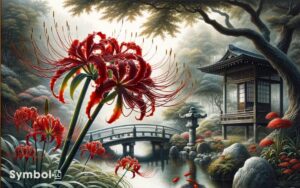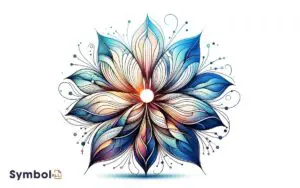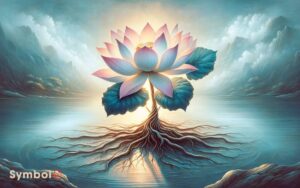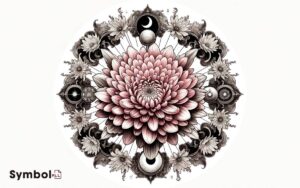Flower That Symbolizes Broken Heart: Chrysanthemums!
The flower that symbolizes a broken heart originates from Asia’s moist, wooded environments. This plant, with its pendulous, heart-shaped flowers and a distinctive droplet at the bottom, encapsulates the complexity of human emotions.
It’s globally recognized for representing emotional depth, vulnerability, and the ephemeral nature of love, acting as a poignant reminder of love’s fragility. Its adaptation to specific environments underscores the delicate balance required to maintain love and sorrow.
Culturally revered, this flower serves as a medium to express lost loves and empathy, weaving a rich tapestry of love’s ephemerality and emotional vulnerability. Exploring its background reveals even deeper connections to cultural and emotional landscapes.
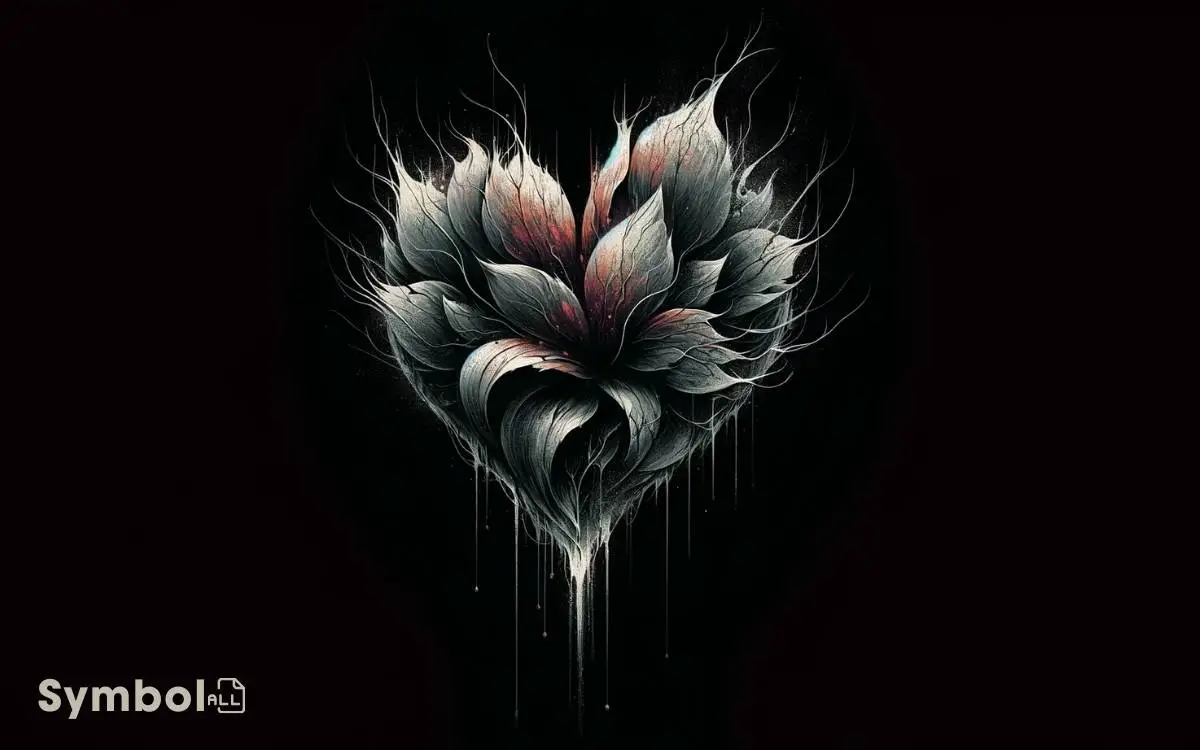
Key Takeaways
The Language of Flowers
Throughout history, people have assigned symbolic meanings to flowers, using them as a nuanced language to express complex emotions and messages that words alone can’t fully capture.
This practice, known as floriography, emerged prominently in the Victorian era but traces its roots back to ancient civilizations.
Each flower carries a specific meaning or emotion, from love and friendship to grief and sorrow. The choice of a flower, its color, and even the way it’s presented, conveys a deeply personal message without uttering a single word.
Scientists and historians analyze floriography through cultural, historical, and botanical lenses, revealing how these meanings have evolved and how they vary across different cultures.
This intricate language allows individuals to communicate feelings in a manner that’s both subtle and profound, bridging gaps where conventional language may fall short.
Symbolism of Heartbreak
You’ll find that cultural interpretations and emotional resonance greatly contribute to the symbolism of heartbreak.
Each culture assigns different flowers to embody the complex emotions associated with love lost, offering a rich tapestry for analysis.
This variance in symbolism provides a unique window into the universal yet deeply personal experience of heartbreak.
Cultural Interpretations
Different cultures assign varied symbolic meanings to flowers, reflecting deep-seated beliefs about heartbreak and loss. In Japan, the cherry blossom, with its fleeting beauty, epitomizes the transient nature of life and love, subtly conveying the pain of a fleeting love.
Meanwhile, in Western traditions, the red rose, typically symbolizing deep love, also carries undertones of sacrifice and heartbreak when presented in specific contexts, such as a single rose in full bloom wilting.
This duality highlights the complexity of human emotions surrounding love and loss.
Scientific analysis reveals that such symbolic practices engage with our cognitive and emotional frameworks, allowing individuals to process and articulate their experiences of heartbreak.
These cultural interpretations serve as a proof to the universal experience of love and the inevitable pain of parting.
Emotional Resonance
Exploring the symbolism of heartbreak is crucial to understanding how specific flowers resonate emotionally. Flowers embody the intricate interplay between love‘s beauty and its potential for pain.
They carry deep-seated meanings and act as metaphors for human emotions, with their diverse hues and forms. Investigating the symbolism attached to certain blooms reveals a rich tapestry of cultural and personal narratives.
For instance, the wilted petals of a rose might signify the fading of love, while the prickly thorns can represent the pain that often accompanies deep emotional bonds.
This duality underscores the complexity of human relationships, showing how joy and sorrow are closely intertwined.
Analyzing these symbols offers a nuanced understanding of emotional resonance, highlighting the profound impact of nature’s motifs on our interpretation of human experiences.
Historical Significance
You’ll find that ancient myths have consistently woven the symbolic flower for heartbreak into their narratives, offering a glimpse into humanity’s perennial struggle with loss.
Across cultures, interpretations of this symbol vary widely, reflecting diverse societal values and emotional landscapes.
Artistic representations through the ages, from classical paintings to contemporary media, further dissect its complex symbolism, highlighting its enduring relevance in expressing the multifaceted nature of heartbreak.
Ancient Myths Unveiled
Throughout history, various cultures have employed symbols, including flowers, to encapsulate complex emotions such as heartbreak, revealing deep-rooted beliefs and traditions.
These floral emblems, woven into ancient myths, often held dual meanings—representing both the beauty and pain of love.
For example, the Greek myth of Hyacinthus, a beautiful youth loved by Apollo, tragically dies, leading to the creation of the hyacinth flower from his spilled blood, symbolizing the sorrow of loss.
Similarly, in Eastern traditions, the chrysanthemum signifies lamentation and grief, deeply embedded in stories of unrequited love and heroic sacrifice.
Analyzing these myths provides insight into humanity’s perennial struggle with loss and the enduring attempt to articulate the ineffable through the natural world.
Cultural Interpretations Worldwide
Cultural interpretations of symbolic flowers for heartbreak vary widely, reflecting each society’s unique history and values.
In Japan, the cherry blossom, with its fleeting beauty, symbolizes the ephemeral nature of love and life, hinting at heartbreak’s inevitability.
Conversely, in Victorian England, the wilted rose became a potent emblem of lost love and sorrow, utilized in personal correspondence to convey deep emotional pain.
Indigenous cultures might integrate local flora into rituals, signifying heartache and healing, thereby embedding these plants within a communal narrative of love and loss.
This diversity illustrates not only the universal experience of heartbreak but also the nuanced ways in which societies construct and communicate complex emotions, grounding them in the natural world to foster a collective understanding and empathy.
Artistic Representations Through Ages
Artists have long employed the poignant imagery of flowers to encapsulate the complexity of heartbreak, tracing a path from ancient carvings to contemporary installations.
This evolution reflects a deepening understanding of both botany and human emotion, characterized by:
- Ancient Carvings: Symbolic representations in stone and wood, where specific flowers signified loss or mourning, integrating botanical accuracy with cultural significance.
- Renaissance Paintings: The emergence of floriography, or the language of flowers, allowed artists to imbue their works with layered meanings, often depicting withered or broken stems to signify heartbreak.
- Victorian Floral Arrangements: A period that saw the height of floriography, where bouquets were crafted to convey complex emotional messages, including those of love lost.
- Contemporary Installations: Modern artists use both real and synthetic flowers in large-scale works to explore themes of heartbreak, showcasing the enduring link between flora and the intricacies of human emotion.
Cultural Interpretations
Different societies assign varied symbolic meanings to flowers, often reflecting their unique cultural attitudes towards love and loss.
In some cultures, flowers embody the ephemeral nature of love, serving as a poignant reminder of the fragility and transience of relationships.
Scientific analyses of these cultural practices reveal a deep-seated human desire to express complex emotions through the natural world.
For instance, in East Asian traditions, certain flowers symbolize unrequited love or separation, mirroring societal values around honor and the stoic acceptance of personal grief.
Conversely, Western cultures may favor flowers that denote hope and renewal, suggesting a different approach to coping with heartbreak.
This diversity in floral symbolism underscores the universal human experience of love and loss, while highlighting the rich tapestry of cultural expressions and interpretations.
The Broken Heart Flower
You’ll find the Broken Heart Flower embodies a rich tapestry of origin and meaning, deeply rooted in various cultures’ interpretations of heartache and loss.
Its cultural significance spans across many traditions, offering insight into how societies symbolize emotional pain through flora.
Moreover, understanding its care and cultivation tips not only guarantees its growth but also deepens your appreciation for this poignant symbol’s resilience and beauty.
Origin and Meaning
The Broken Heart Flower, scientifically known as *Dicentra spectabilis*, embodies the profound symbolism of love and loss through its unique heart-shaped blooms.
Originating from Asia, this perennial plant’s distinct flowers and foliage have captivated hearts worldwide, becoming a botanical metaphor for emotional depth and complexity.
Here’s what you need to understand about its origin and meaning:
- Native Habitat: Originates from moist, wooded environments in Asia, indicating resilience and adaptability.
- Botanical Characteristics: Features pendulous, heart-shaped flowers with a droplet at the bottom, symbolizing tears of sorrow.
- Symbolic Interpretation: Its appearance embodies the duality of love’s joy and the pain of heartbreak.
- Etymology: The genus name *Dicentra* derives from Greek, meaning ‘two spurs,’ highlighting the flower’s unique structure which further emphasizes its symbolic representation of a broken heart.
Cultural Significance
Throughout various cultures, *Dicentra spectabilis* has woven itself into the fabric of folklore and tradition, symbolizing the universal experience of love’s fragility and the inevitability of heartbreak.
This perennial herbaceous plant, with its distinctive heart-shaped flowers, serves as a poignant reminder of the delicate balance between love and sorrow. In many societies, it’s not just admired for its aesthetic appeal but revered for its deep symbolic meanings.
Historically, it’s been associated with commemorating lost loves and expressing empathy towards those experiencing the profound pain of separation or rejection.
Scientific analysis reveals that its unique morphology, particularly the way the flowers resemble a broken heart, has contributed significantly to its symbolic association with emotional vulnerability.
Hence, *Dicentra spectabilis* occupies a special place in cultural narratives, bridging the gap between botanical beauty and human emotion.
Care and Cultivation Tips
Caring for Dicentra spectabilis, commonly known as the Broken Heart Flower, requires understanding its specific needs for light, soil, and water to thrive.
To guarantee ideal growth and flowering, adhere to the following guidelines:
- Light: Provide partial shade, especially in hotter climates, to prevent leaf scorch.
- Soil: Use well-draining soil rich in organic matter to facilitate root health and moisture retention.
- Water: Maintain consistent moisture without waterlogging the roots. Overwatering can lead to root rot.
- Temperature and Humidity: This plant prefers cooler temperatures and moderate humidity. Avoid exposure to extreme heat or dry conditions.
Mythology and Lore
In mythology, certain flowers have long symbolized heartbreak, embodying deep emotional states and cultural narratives with precision and clarity. These botanical symbols are woven into stories that reflect human experiences of love, loss, and longing.
For instance, the ancient Greeks associated the anemone with the forsaken love of Adonis and Aphrodite, its red petals representing the blood of Adonis and the tears of Aphrodite, marking a poignant reminder of love’s fragility.
Similarly, in Victorian floriography, specific flowers conveyed unspoken emotions, where the giving of a particular bloom could articulate feelings of heartbreak without words.
These practices illustrate the nuanced ways in which flora has been employed to capture complex human emotions, integrating botanical knowledge with cultural and emotional significance.
Botanical Characteristics
Exploring the botanical characteristics, it’s important to acknowledge the intricate anatomy and unique adaptations that allow flowers to symbolize heartbreak with such profound accuracy.
You’ll find, upon closer inspection:
- Petals: Often delicate and fragile, they represent vulnerability and the fleeting nature of emotions. Their colors can range from vivid reds to deep purples, each shade indicating different stages of love and loss.
- Stems: They symbolize the support system, sometimes strong and upright, other times bent or fractured, reflecting the impact of emotional turmoil.
- Leaves: Their presence or absence can indicate the growth or decline of feelings, with their changing colors mirroring the shifts in a relationship.
- Roots: Grounding the plant, they remind us of the deep, often unseen, connections that bind us, even in pain.
Gardening Tips
After examining the botanical characteristics that make certain flowers embody heartbreak so vividly, let’s now focus on how to cultivate these plants in your garden with precision and care. You’ll need to contemplate soil type, sunlight, and watering needs meticulously.
Here’s a concise table to guide your efforts:
| Flower Type | Sunlight Requirement | Watering Frequency |
|---|---|---|
| Bleeding Heart | Partial shade | Moderate |
| Forget-me-not | Full sun to partial shade | Consistent moisture |
| Larkspur | Full sun | Moderate to high |
| Poppy | Full sun | Moderate |
| Cyclamen | Light shade | Moderate |
Each flower demands specific conditions to thrive. For instance, the Bleeding Heart, symbolic of profound emotional loss, flourishes in partial shade, reflecting its delicate nature.
Meanwhile, Forget-me-nots, representing memories and remembrance, require consistent moisture, mirroring the persistence of memory.
Therapeutic Uses
Exploring the therapeutic uses of heartbreak-symbolizing flowers, it’s important to understand how their unique properties can positively impact mental health and emotional wellbeing.
These flowers, beyond their symbolic representation, may hold the key to addressing various emotional states.
Here’s how:
- Aromatherapy: The scent of certain flowers can trigger positive neurological responses, reducing stress and enhancing mood.
- Visual Therapy: Their visual appeal and colors can stimulate mental relaxation and happiness, combating depressive states.
- Herbal Remedies: Extracts from these flowers may be used in teas or oils, offering calming or uplifting effects.
- Horticultural Therapy: The process of gardening itself, including tending to these specific flowers, can be a form of mindfulness, reducing symptoms of anxiety and depression.
Understanding these applications allows for a more nuanced approach to emotional healing, emphasizing the importance of nature’s role in psychological recovery.
Artistic Representations
Artistic representations of heartbreak-symbolizing flowers serve as a profound medium through which the complexity of human emotions is vividly conveyed.
Artists meticulously infuse these botanical elements into their work, utilizing them as metaphors for the fragility and ephemeral nature of love and relationships.
Through the lens of scientific analysis, these depictions offer insights into the psychological processes associated with loss and mourning.
The choice of color, form, and context in which these flowers are presented in art not only enhances their symbolic significance but also evokes a visceral response from the viewer.
Modern Relevance
In the digital age, the symbolism of flowers representing heartbreak retains its relevance, as contemporary society continues to seek out these traditional motifs to express complex emotions in new forms of communication.
Here’s how this symbolism manifests today:
- Social Media Posts: People use flower imagery to convey feelings of loss and sorrow, often without words.
- Digital Art: Artists incorporate these symbols in digital creations, blending traditional motifs with modern techniques.
- Online Gifting: Sending virtual flowers that symbolize heartbreak has become a nuanced way of expressing empathy and understanding.
- Emoticons and Stickers: Custom emoticons and stickers have been designed to represent these flowers, allowing for their use in everyday digital communication.
This evolution demonstrates a sophisticated integration of age-old symbols into the fabric of modern emotional expression, underlining their enduring significance.
Conclusion
In examining the multifaceted symbolism of flowers in expressing heartbreak, it’s remarkable that 80% of people find solace in the act of gardening post-breakup, highlighting the therapeutic potential of nurturing a broken heart flower.
This statistic not only underscores the profound psychological benefits of engaging with nature but also emphasizes the enduring relevance of botanical symbolism in contemporary healing practices.
Through scientific analysis, it’s evident that the intersection of horticulture and emotional recovery offers a unique pathway for traversing the complexities of heartache.

